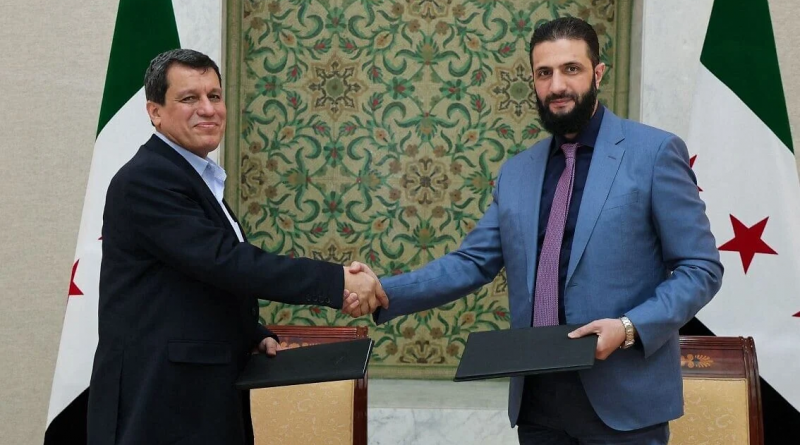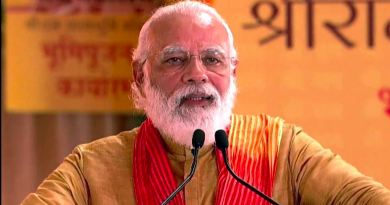Syria’s New Government Strikes Landmark Deal with Kurdish-Led SDF to Reunify Nation
Damascus – In a pivotal moment for post-conflict Syria, the interim Syrian government under President Ahmed al-Sharaa has signed a historic agreement with the Kurdish-led Syrian Democratic Forces (SDF) to fully integrate the institutions of the autonomous northeast into the national framework.
The announcement, made Monday by the Syrian presidency, marks a breakthrough in efforts to reunite the country after more than 13 years of civil war and internal fragmentation. The deal signals the beginning of the end of parallel administrations in Syria’s north and east and reasserts central authority over critical regions long outside Damascus’ direct control.
A statement published by the presidency emphasized that “all civilian and military institutions in the northeast, including border posts, airports, and oil and gas fields, will now be integrated under the administration of the Syrian state.”
State media also released a photograph of President Sharaa shaking hands with SDF commander Mazloum Abdi, underlining the significance of the agreement. The document declared that “the Kurdish community is an essential component of the Syrian state” and reaffirmed its rights to full citizenship and constitutional protections.
End of Division?
The agreement comes just days after severe violence erupted in Syria’s coastal Alawite heartland — the community from which former president Bashar al-Assad hailed. This outbreak, sparked by attacks from Assad loyalists, represented the most serious internal security challenge since Assad was ousted in December.
According to the Syrian Observatory for Human Rights, over 1,000 civilians—primarily Alawites—were killed in a brutal crackdown by new government forces. Additionally, 231 security personnel and 250 pro-Assad fighters lost their lives during the clashes.
Despite the bloodshed, the government declared the operation concluded on Monday and shifted its focus to stabilizing the country through national integration. The timing of the SDF agreement suggests a strategic pivot toward unity, following the decapitation of Assad-era loyalist resistance.
SDF’s Strategic Role
The SDF, which emerged during the civil war as a U.S.-backed force, had established a de facto autonomous administration across much of northern and eastern Syria, including areas rich in oil and gas — resources critical to Syria’s post-war reconstruction.
The group, led largely by Kurdish forces, was instrumental in defeating ISIS in its final territorial stronghold in 2019. However, the SDF’s refusal to disarm had led to their exclusion from a recent national dialogue conference hosted by Syria’s new authorities.
The current agreement, however, offers a compromise: recognition and inclusion in exchange for institutional integration. The document also stresses support from the SDF in the government’s campaign against “remnants of Assad’s forces and all threats to Syria’s unity and security.”
A Reversal of History
For decades under the Assad regime, Syria’s Kurdish population was systematically marginalized. Many were denied citizenship, barred from using their language, and forbidden from celebrating their cultural identity.
The tide turned during the civil war, when the Syrian military’s withdrawal from the north enabled Kurdish groups to establish local governance. Yet, their ties to the Kurdistan Workers’ Party (PKK)—a group designated as a terrorist organization by Turkey, the U.S., and the EU—complicated relations with regional and international powers.
Despite Ankara’s concerns, the SDF insists it operates independently of the PKK. However, its backbone—the Kurdish People’s Protection Units (YPG)—is widely considered by Turkey to be an extension of the PKK. Turkish forces have routinely targeted Kurdish-held areas in northern Syria and supported proxy militias against them.
The agreement with Syria’s new authorities, who have established close ties with Turkey since Assad’s fall, could reduce Ankara’s justification for continued military action—provided the SDF’s integration is fully realized and verified.
A Step Toward Peace?
The timing of this deal is also significant in light of a recent call from jailed PKK founder Abdullah Öcalan, urging the group to disband and abandon armed struggle. If realized, the dissolution of the PKK could signal a new era of regional stability, and the SDF’s absorption into Syrian state structures may mark a move away from militia rule toward centralized governance.
While challenges remain, including Turkish military presence and latent sectarian divisions, the agreement could serve as the first genuine blueprint for Syria’s reunification — built not on military might, but on negotiation and mutual recognition.



